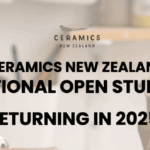Your cart is currently empty!
Tales of a Red Clay Rambler: Ben Carter interviews…
Richard Stratton on the Importance of Technical Research on Aesthetic Development
Richard Stratton uses late 19th Century industrial ceramic techniques to make sculptural vessels that are steeped in the aesthetics of cubism and modernist architecture. In our interview we talk about how mud larking on the banks of the Thames reignited his interest in English industrial ceramics, the importance of research on aesthetic development, and selling ceramics in the NZ fine art market.
Listen to the interview
Nicole Kolig on Harvesting Local Ceramic Materials for Sculpture
Nicole Kolig’s studio and farm are nestled into the side of an extinct cinder cone volcano that rises above the surrounding Otago Peninsula outside of Dunedin, NZ. In our interview we talk about her time working with indigenous artists in the Kimberly region of Australia in the early 1970s, harvesting local ceramic materials for sculpture, and the history of the Ceramic Association of New Zealand.
Listen to the interview
Cheryl Lucas on Creativity as a Counterpoint to Cultural Trauma
In 2011 multiple earthquakes hit Cheryl Lucas’s home area of Christchurch, devastating the city and creating a turning point in her work. She has reacted to the destruction and subsequent rebuilding of the city with multiple bodies of work that deal with the events. In our interview we talk about making art as a way to make sense of tragedy, transitioning between the technical and conceptual aspects of making, and helping to rebuild the city by making large scale chimney pots used on historic buildings.
Listen to the interview
Tatyanna Meharry and Gwen Parsons on New Zealand’s Distance Learning Programme
A large part of our interview with with Tatyanna Meharry and Gwen Parsons focuses on Otago Polytechnic’s Diploma in Ceramic Arts program. Tatyanna is the head of the Christchurch satellite, where she facilitates a two-year programme guiding students through the ceramics curriculum, and Gwen is currently a second-year student in the programme. In the interview we also talk about the history of ceramic education in New Zealand, diversifying the income of a business, and rebuilding Christchurch after the 2011 earthquakes.
Listen to the interview
Chris Weaver on Twenty-five Years of Exploring the Teapot Form
After rediscovering his grandmother’s Iron, Chris Weaver started making teapots that referenced its angular form. This has led to twenty-five years of exploring the form through a variety of firing techniques and forming methods. In our interview we talk about incorporating wooden parts into his functional ceramics, keeping the teapot form fresh, and making tools to create specific marks in clay.
Listen to the interview
Michael O’Donnell on the Spiritual Aspect of Ecology
A longtime resident of the Coromandel region, Michael O’Donnell is an environmental advocate that uses ceramic sculpture to tell the story of the local ecology. His role as artist, story teller and spiritual seeker has been spurred on in defiance of multinational mining corporations that are working in the region. In our interview we talk about the influence of Barry Brickell, creativity as an antidote to depression, and Maori spiritual beliefs about water.
Listen to the interview
Duncan Shearer on Experimental Kiln Firings
Duncan Shearer’s interest in atmospheric firing has led him to build kilns from nontraditional materials, such as wood blocks, telephone directories, and ice. These performance firings captivate audiences and have informed the kilns he has built at his studio in Paeroa, NZ. In our interview we talk about firing as a communal activity, the geologic diversity of the Coromandel Range, and his interest in the Albarello form used in medieval Europe.
Listen to the interview
Greg Barron on Building Homemade Ceramic Equipment
In the 1970s, Greg Barron started building his own ceramic processing equipment to make plastic clays for use in his studio. He applied this same ingenuity to build an energy efficient home and studio in Whangarei, NZ, that is made from compressed adobe and other ceramic materials. In our interview we talk about the effect deregulating ceramic imports had on New Zealand studio potters in the mid-1980s, how his priorities have shifted with age and experience, and his do-it-yourself philosophy for running a business.
Listen to the interview

